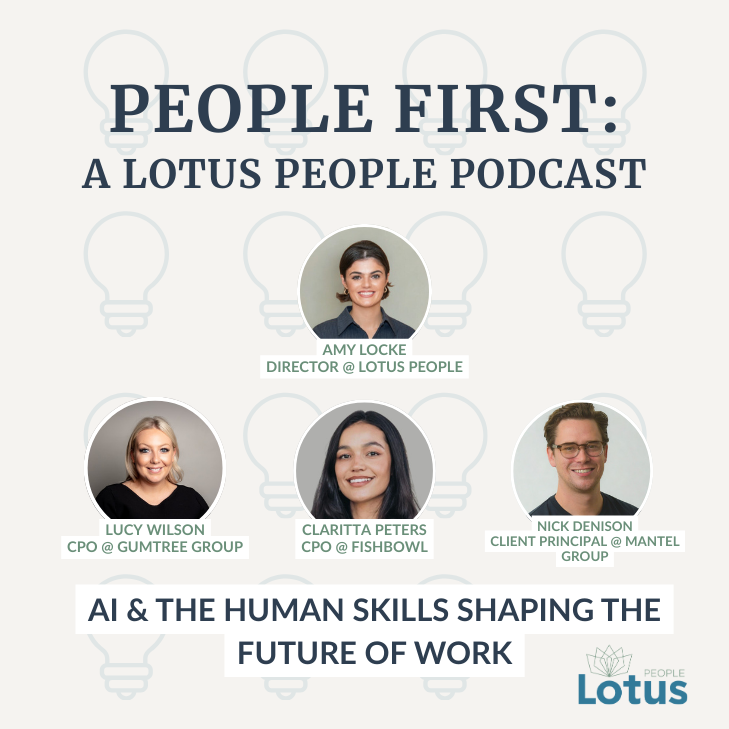Why Your EVP Matters Now More Than Ever
Your EVP (Employee Value Proposition) is more than a feel-good statement on your careers page. It’s the entire experience of what it means to work for your organisation. And in 2025, where employee expectations are shifting faster than ever, a clear and authentic EVP isn’t a nice-to-have, it’s your competitive edge.
Yet according to Lotus People’s 2025 Market Survey, nearly half of hiring managers don’t feel confident their EVP is strong enough to attract and retain the right people. And that’s a problem.
A vague or outdated EVP leads to poor hiring alignment, disengaged employees, and preventable turnover. In contrast, a strong, lived EVP drives retention, empowers internal culture, and gives hiring managers the language to confidently bring new people in.
What Exactly
Is
an EVP?
An Employee Value Proposition defines the total value an employee receives in exchange for their contribution to the business. That includes:
- Tangible benefits (salary, flexibility, bonuses, leave, development)
- Intangible benefits (culture, purpose, leadership, learning environment)
- The broader employee experience (how people are recognised, led, and supported)
It should answer two questions clearly:
- Why should someone choose to work here?
- Why should they stay?
Your EVP exists whether you’ve defined it or not. The risk lies in assuming it’s clear, or that people are experiencing it the way it’s intended.
How to Build a Compelling EVP
1. Start by Evaluating What You Already Do Well
Take stock. What does your organisation offer — formally and informally — that your people value? Look at:
- Current benefits, flexibility, and development opportunities
- Unique elements of your culture and leadership style
- Retention success stories or high-performing team attributes
Document this baseline.
2. Talk to Your People
Your employees already know your EVP — or lack of one. Use engagement surveys, interviews, and exit data to find themes. What do people love? What’s missing? What do they tell each other about working here?
3. Map Your EVP Pillars
Structure your EVP around 4–6 core pillars, such as:
- Career development
- Recognition and reward
- Flexibility and wellbeing
- Leadership and culture
- Purpose and impact
Each pillar should be specific, not vague. Avoid saying “we offer flexibility” — say what kind, how often, and how it's lived.
4. Get Buy-In From Leaders and Hiring Managers
EVP isn’t a HR silo project. Leaders shape it. Hiring managers communicate it. Employees experience it.
Hold EVP sessions with managers to:
- Align messaging across the business
- Ensure everyone understands their role in bringing it to life
- Identify inconsistencies between what’s promised and what’s delivered
5. Document It Clearly — Without Overcomplicating It
Your EVP doesn’t need to be a 20-page deck. It needs to be clear, accessible, and actionable. Consider:
- 1 internal guide for hiring managers and leaders
- 1 externally facing summary for candidates (careers page, job ads, interviews)
- Optional: short videos, testimonials, visual explainer content
6. Embed and Communicate It
Use your EVP language consistently — in onboarding, career conversations, job postings, and leadership comms.
Hiring managers should be able to confidently say:
“Here’s how we support you to grow, here’s what flexibility looks like here, and here’s how we recognise great work.”
7. Review, Refine, and Evolve
Your EVP should shift as your company evolves. Set a cadence to review it annually — using fresh employee feedback and external market changes. It’s not static; it’s a living reflection of your culture and offering.
Examples of What a Strong EVP Actually Looks Like:
“All employees receive tailored career progression pathways, reviewed every six months.”- “We do annual remuneration reviews for every role, not just high performers.”
- “Work the hours that suit your life — our flexible model empowers you to do your best work.”
- “You’ll be part of a mission-driven team where your role directly impacts [X outcome].”
An EVP shouldnt be fluff. It’s specific, actionable, and connected to both values and experience.
Final Thought: EVP Isn’t About Perfection - It’s About Clarity
Every organisation has strengths and challenges. Your EVP doesn’t need to paint a perfect picture. But it does need to be honest, intentional, and communicated.
When done right, it becomes one of your most powerful tools - not just for hiring, but for retaining, developing, and inspiring your people.
Want support defining or refreshing your EVP? We work closely with HR and talent teams to help structure EVP messaging, coach hiring managers, and align internal and external messaging. Contact us today!
You may also like...





